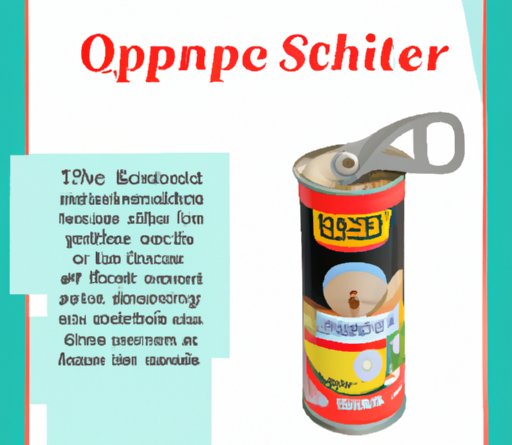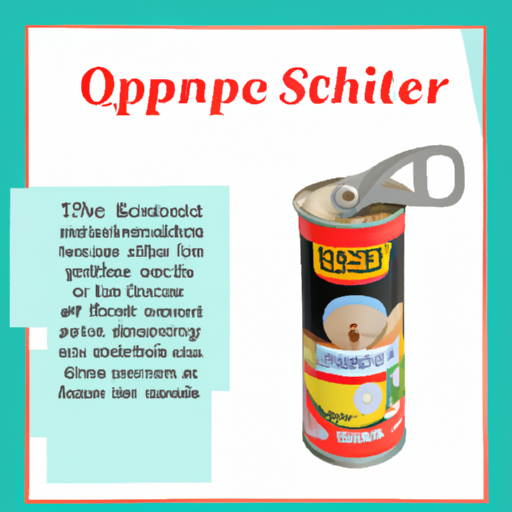
Have you ever found yourself staring at a can opener, unsure of how to use it? Don’t worry, you’re not alone! Learning how to use a can opener may seem like a daunting task at first, but with the right guidance, you’ll be able to open cans effortlessly in no time. In this article, we’ll break down the steps for you and guide you through the process of using a can opener. So, let’s get started and demystify the world of can openers!
Table of Contents
How to Use a Can Opener
Using a can opener may seem like a simple task, but there are actually a few different types and variations to be aware of. From manual can openers to electric ones, there’s a variety of tools designed to make this process easier for you. In this article, we’ll focus on the traditional manual can opener, which is widely available and commonly used in households. We’ll go over the basic steps of using a manual can opener, including how to properly position the opener on the can, turn the handle, and safely remove the lid. Whether you’re a beginner or just looking for a refresher, this article will provide you with all the information you need to confidently use a can opener. So, keep reading to become a pro at opening cans effortlessly!
Choosing the Right Can Opener
Consider the Different Types of Can Openers
When it comes to choosing a can opener, there are several options available in the market. Understanding the different types will help you make an informed decision and select the best one for your needs.
- Manual Can Opener: This traditional type of can opener requires manual effort to open cans. It is operated using a rotary handle that rotates the cutting blade around the can’s lid. Manual can openers are known for their simplicity and durability.
- Electric Can Opener: If you prefer a more effortless approach, an electric can opener might be the right choice for you. This type of can opener operates using electricity and automatically opens the can with just a push of a button. Electric can openers are convenient and suitable for individuals with limited hand strength.
- Safety Can Opener: Safety can openers are designed to eliminate the risk of sharp edges on the lid or can. They cut along the side of the can’s rim, leaving a smooth and safe edge. Safety can openers are especially popular among families with young children or those concerned about accidental injuries.
Evaluate the Features of Can Openers
When selecting a can opener, it is essential to consider the features that will enhance your overall user experience. Here are a few features to look out for:
- Ergonomic Design: A can opener with an ergonomic design will provide a comfortable grip and reduce strain on your hands. Look for features such as soft-grip handles or cushioned grips that make it easier to operate the can opener for extended periods.
- Built-in Bottle Opener: Some can openers come with an additional feature – a built-in bottle opener. This can be a convenient addition, as it eliminates the need for a separate bottle opener and allows you to open various types of bottles with ease.
- Magnet: A can opener with a built-in magnet can be advantageous. It allows the lid to stick to the can opener, preventing it from falling into the can and making it easier to dispose of the lid afterward.
- Easy Cleaning: Look for can openers that are easy to clean. Removable cutting blades or detachable parts make it convenient to maintain good hygiene and ensure long-lasting performance.
Read Reviews and Recommendations
Before making a purchase, it is always a good idea to read reviews and recommendations from other users. Customer reviews can provide valuable insights into the performance and durability of different can openers.
Online platforms, such as e-commerce websites, often feature customer reviews alongside product listings. You can also join online forums or seek recommendations from friends and family who have experience using specific brands or models of can openers.
Taking the time to research and read reviews will help you make an informed decision and choose a can opener that meets your requirements.
Preparing the Can and Can Opener
Inspect the Can for Damage
Before using your can opener, it is essential to inspect the can for any signs of damage or deformities. A damaged can may have sharp edges or its contents may have leaked, compromising the quality and safety of the food inside.
Look for dents, bulges, or rust on the can’s surface. If you notice any such damage, it is best to discard the can and choose a new one. Using a damaged can can be hazardous and potentially lead to contamination or injury.
Clean the Can Opener
Maintaining proper hygiene is crucial when using a can opener to avoid any cross-contamination. Before using your can opener, make sure to clean it thoroughly.
Start by using warm, soapy water to clean the cutting blade and other parts of the can opener. Pay close attention to removing any food particles or residue that may have accumulated on the blades or gears. Rinse the can opener thoroughly to remove any soap residue, and towel dry it or let it air dry.
Regular cleaning of your can opener not only keeps it in good working condition but also ensures the safety and cleanliness of the food you are opening.
Ensure Proper Grip on the Can
To ensure a smooth and hassle-free experience, it is crucial to have a secure grip on the can. This will help prevent accidents and provide better control while using the can opener.
Hold the can firmly with one hand, ensuring your fingers are positioned away from the cutting mechanism. This will prevent any accidental contact with the sharp cutting blade. With a secure grip on the can, you can confidently operate the can opener and open the can effectively.
Using a Manual Can Opener
Position the Can Opener Correctly
To use a manual can opener, you need to position it correctly on the top of the can. Align the cutting wheel with the edge of the can’s lid, ensuring that the blade is in contact with the can.
Hold the can opener in a way that provides stability and control. The handle should be gripped firmly to prevent any slips or accidents during the opening process.

Attach the Can Opener to the Can
Once the can opener is correctly positioned, press the cutting wheel into the can’s lid. Apply slight pressure, and slowly rotate the handle in a clockwise direction. The cutting wheel will begin to pierce through the lid, creating a smooth and clean cut.
Continue rotating the handle until you have made a complete circle around the can’s lid. At this point, the lid should be partially detached from the can, but still connected at one or two points.
Turn the Can Opener Handle to Open the Can
To fully open the can, use the can opener’s handle to lift the partially detached lid. Apply gentle pressure to create a gap between the lid and the can. With one hand holding the can opener handle and the other hand holding the can firmly, lift the lid away from the can.
Be cautious while handling the lid, as it may have sharp edges. It is advisable to dispose of the lid appropriately to prevent any accidental injuries.
Using a manual can opener requires a bit of effort, but with practice, you will quickly master the technique and open cans effortlessly.
Using an Electric Can Opener
Place the Can in the Electric Can Opener
Using an electric can opener is a simple and convenient way to open cans with minimal effort. To begin, place the can on a flat surface, ensuring that it is centered beneath the electric can opener’s cutting mechanism.
Electric can openers usually have adjustable arms or guides to hold the can securely in place. Check that the can fits snugly against the arm or guide before proceeding.
Activate the Can Opener
Once the can is correctly positioned, activate the electric can opener by pressing the designated button or switch. The cutting mechanism will then engage and start rotating around the can’s lid.
Most electric can openers operate automatically, so you can sit back and let the device do the work for you. As the cutting mechanism rotates, it will gradually open the can, creating a smooth and clean cut along the lid.
Remove the Can’s Lid
Once the electric can opener has completed the opening process, it is time to remove the lid. Lift the can from the electric can opener and set it aside on a flat surface.
Inspect the lid to ensure it is fully detached from the can. If any parts of the lid are still connected, use your fingers or a utensil to gently lift it away from the can.
Be cautious while handling the lid, as it may have sharp edges. Dispose of the lid appropriately to minimize the risk of injury.
Using an electric can opener is quick, effortless, and ideal for those who prefer a hands-free approach to opening cans.
Troubleshooting Common Issues
While using a can opener, you may encounter some common issues that can hinder the smooth operation of the tool. Understanding how to troubleshoot these issues can help you overcome any obstacles and continue using your can opener effectively.
Difficulty Turning the Can Opener Handle
If you are using a manual can opener and find it challenging to turn the handle, consider the following solutions:
- Ensure that the can opener is correctly positioned on the can, aligned with the lid’s edge.
- Apply a small amount of cooking oil or lubricant to the cutting wheel and gears of the can opener. This will reduce friction and make it easier to turn the handle.
- If the handle is loose or wobbly, check if any screws or bolts need tightening. An unstable handle can impede smooth operation.
Can Opener Not Gripping the Can
When your can opener fails to grip the can securely, try the following troubleshooting steps:
- Verify that the can opener is adjusted to fit the size of the can. Many can openers have adjustable arms or guides that need to be in the correct position to grip the can effectively.
- Clean the cutting blade and any movable parts of the can opener. Dust, debris, or food residue can hinder the can opener’s gripping ability.
- Check if the cutting blade is sharp and in good condition. Dull or damaged blades may not grip the can properly, resulting in a less effective opening process.

Can Opener Blades Not Cutting Properly
If the can opener blades are not cutting through the can smoothly, you can try the following troubleshooting techniques:
- Ensure that the can opener is correctly positioned on the can and that the cutting blade is aligned with the can’s lid. Misalignment can cause the blades to slip or not cut properly.
- Clean the cutting blade and gears thoroughly. Removing any debris or food residue from the blades will improve their cutting performance.
- If the blades appear dull or damaged, consider replacing them with new ones. Dull blades can make the opening process more challenging and less efficient.
Cleaning and Maintenance
Regularly Clean the Can Opener
To maintain the performance and longevity of your can opener, regular cleaning is essential. The accumulation of food particles and residue can hinder the can opener’s functionality and compromise hygiene.
After each use, rinse the can opener with warm, soapy water to remove any debris or stuck-on food. Pay special attention to the cutting blade and other movable parts, ensuring optimal cleanliness.
Remove any Residue or Build-up
Over time, residue or build-up may accumulate on the can opener, making it harder to clean. Stubborn residue can be removed by soaking the can opener in a mixture of warm water and dish soap for a few minutes.
Gently scrub the can opener using a soft brush or toothbrush, making sure to reach all the nooks and crannies. Rinse the can opener thoroughly, removing any soap residue, and dry it completely before storing it away.
Oil the Moving Parts
Periodically oiling the moving parts of your can opener will help keep it operating smoothly. Apply a small amount of food-grade lubricant or cooking oil to the gears, cutting blade, and other movable components.
Wipe away any excess oil or grease, ensuring that the oil is evenly distributed on all the necessary parts. Regular oiling will reduce friction and prevent the can opener from becoming stiff or difficult to operate.
Safety Precautions
Avoid Placing Fingers Near the Cutting Mechanism
When using a can opener, it is crucial to keep your fingers away from the cutting mechanism at all times. The sharp cutting blade can cause severe injury if it comes into contact with your fingers or hand.
Always hold the can securely while using the can opener, ensuring that your fingers are positioned away from the blade. Proper hand placement will reduce the risk of accidental cuts or lacerations.
Keep Can Opener Away from Water
Water is the enemy of most can openers, especially manual ones with metal parts. Avoid submerging the can opener in water or exposing it to excessive moisture, as this can lead to rusting or damage.
When cleaning your can opener, use a damp cloth or sponge to wipe away any residue or food particles. Dry the can opener thoroughly before storing it away to prevent moisture-related issues.
Disconnect Electric Can Opener when Not in Use
If you are using an electric can opener, it is essential to disconnect it from the power source when not in use. Leaving it plugged in unnecessarily can pose a safety risk, especially if it is within reach of children.
Disconnecting the electric can opener will prevent any accidental activation and ensure the safety of everyone in your household. It is a simple step that can help prevent potential accidents.
Benefits of Using a Can Opener
Efficiency and Time-Saving
Using a can opener provides a quick and efficient way to access the contents of canned goods. Whether using a manual or electric can opener, you can open cans with minimal effort, saving time and energy in the process.
Gone are the days of struggling with other improvised methods or utensils to open cans. A reliable can opener allows you to enjoy your favorite canned foods effortlessly and without delays.
Preserves the Integrity of Food Packaging
Canned goods are meticulously sealed to ensure the freshness and quality of the food inside. Using a can opener designed specifically for this purpose helps maintain the integrity of the packaging.
When using a can opener, you minimize the risk of damaging the can or its contents, preventing spoilage or contamination. The smooth and clean cut from a reliable can opener ensures that the food remains well-preserved until you are ready to consume it.
Reduces the Risk of Injury
Improper methods or tools for opening cans can be dangerous and increase the risk of injuries. Using a can opener designed for the task minimizes the risk of accidental cuts, punctures, or other mishaps.
Can openers are designed with safety features that aim to protect users from potential harm. With proper use and adherence to safety precautions, a can opener provides a secure and risk-free method for opening cans.
Alternative Methods for Opening Cans
While using a can opener is the most efficient and safe way to open cans, there may be situations where a can opener is not readily available. In such cases, here are a few alternative methods that can be employed:
Using a Knife
If you find yourself without a can opener, a knife can be used as an alternative. While this method requires caution and precision, it is possible to open a can using a sturdy blade.
Using a firm grip on the can and a sharp knife, pierce the lid by placing the tip of the knife on the lid’s edge and applying downward pressure. Gradually work your way around the lid, creating a cut until it is fully detached.
Using a Spoon
Another alternative method involves using a spoon to open a can. This method is suitable for cans with pull tabs or lids that are partially detached.
Insert the spoon’s tip into the gap between the lid and the can. Apply gentle pressure and move the spoon along the edge of the lid, using it as a lever to pry the lid open.
Using a Puncture Can Opener
Puncture can openers are compact tools specifically designed for emergencies or outdoor activities. These handheld devices feature a sharp point that can pierce the lid of a can, allowing you to access its contents.
To use a puncture can opener, hold it firmly and place the point against the lid’s surface. Apply pressure and rotate the opener, creating a circular cut along the lid. Continue until the lid is partially or completely open, providing access to the food inside.
While these alternative methods can be useful in certain situations, they may not always be as efficient or safe as using a dedicated can opener. It is advisable to have a reliable can opener on hand to ensure consistent and safe access to canned food.
Conclusion
Using a can opener is a simple and convenient way to access the contents of canned goods. By following the proper steps and taking necessary precautions, anyone can effectively use a can opener to open cans of various sizes. Whether using a manual or electric can opener, it is essential to choose the right one, prepare the can and opener appropriately, and clean and maintain the tool for optimal performance. Enjoy the benefits of quick and safe access to your favorite canned foods with a reliable can opener.


